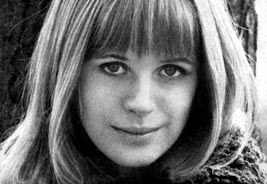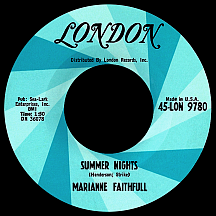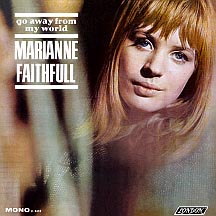MARIANNE FAITHFULL
Andrew Loog Oldham had become one of the trendiest music producers in Britain by 1964, having established The Rolling Stones as a top act the year before. While the rest of the world was beginning to fall under a Jagger-induced spell, Oldham shifted into talent scout mode. Spotting an attractive 17-year-old girl at a party, he decided he could make a singing star out of her. Though she insisted she had never sung before, he persisted, saying he thought she had "a face that could sell records," so she gave it a whirl. Marianne Faithfull's career was under way.
In contrast to the Stones' blues-based rock and roll preference, she started off by going in a folk music direction. Playing in small clubs, she seemed uncomfortable at first, appearing shy and naive in front of crowds, yet her mature singing voice came as a pleasant surprise to everyone including Marianne herself. After Oldham's success with the Stones, he had no problem getting her a contract with Decca Records. "As Tears Go By," written by Mick Jagger, Keith Richards and Oldham, arrived as her debut single, her connection to the "bad boys of rock" providing an automatic edge over the competition. Her heartfelt performance of the ballad (even more effective than the Stones' version, a bigger hit when released in late '65) debuted on the charts in August and made it to the U.K. top ten within a month. She began to feel more comfortable in her new role as a pop star, but it would take a little more time to really settle in.
Born in London's upper class Hampstead district and raised near Liverpool in Ormskirk, West Lancashire, Marianne's parents were hardly typical; her father, a major in the British Army, and mother, an Austrian Baroness and professional ballerina, divorced when she was very young, after which she bounced around between the two and spent some of her formative years attending school in a convent. On her own by the age of 16, she led a waiflike existence, uncertain what her future held until that chance meeting with Oldham established direction. Suddenly under the spotlight she came across as frank and outspoken in interviews, a rarity among female stars of the era, disapproving of what she called "rank commerciality" and "artistic prostitution," establishing an image disaligned with her appearance onstage; she hardly moved a muscle during those early performances, standing or sitting perfectly still while only her lips moved.
A remake of Bob Dylan's "Blowin' in the Wind" floundered as her second single in the fall, a poorly considered follow-up as the Peter, Paul and Mary version had been a U.K. hit just a year before. Decca's American outlet, London Records, serviced "As Tears Go By" to radio at this time and it steadily built up steam, peaking in the the top 30 in January '65. Freedom was given as to many of the songs she could choose to record; a chance meeting with Kentucky-born Jackie DeShannon, on an extended visit to England in late '64, resulted in Marianne's recording of Jackie's "Come and Stay With Me" becoming the third single. It hit the top ten in England in March (her biggest hit at home) while a simultaneous release returned her to the top 30 in America.
Marianne became an often-photographed fan favorite in the British isles. If not yet on a par with contemporaries Cilla Black, Dusty Springfield and Sandie Shaw, she had at least carved a niche of her own, a subtler alternative to those higher-profile singers. Her star shone less brightly across the pond, yet her songs received constant airplay in America throughout 1965; Gene Pitney, a friend and collaborator of the Rolling Stones who was more popular in Britain than at home in the U.S., had toured with Marianne shortly after her first hit. Quite taken with the teenage singer, he composed "Marianne" with her in mind and released it on the flip side of his early '65 hit single "I Must Be Seeing Things."
Another American song, John D. Loudermilk's "This Little Bird," came next, hitting top ten U.K. in May and top 40 U.S. a month later. Then came "Summer Nights," written by Brian Thomas Henderson and singer Liza Strike, an uptempo recording in contrast to the softer approach she'd taken with the other singles. It was her fourth (and last) top ten hit in her homeland and fourth (and last) top 40 hit in America; her peak of popularity had run its course in just one year. "Yesterday," The Beatles' U.S. megahit, wasn't issued as a single in the U.K., so Decca opted to put out a version by Faithfull, but it wound up competing unsuccessfully that fall with a cover by Matt Monro that hit the top ten (on Parlophone, the Beatles' label, no less). London Records in America logically passed on the record, opting instead for "Go Away From My World" (written by little-known songwriter Jay Mark), a ballad more in line with her first three hits, but it stalled on the low end of the charts late in the year.

Her marriage to John Dunbar (the art collector and dealer who later introduced Yoko Ono to John Lennon) was a brief one. They married in May 1965 and she gave birth to his son six months later (during the summer she canceled part of her American tour because of the pregnancy); several months later she left him and began a relationship with Jagger that persisted through highs and lows for several years, during which time she developed a dependance on cocaine, heroin and other drugs. A 1966 appearance in the French film Made in U.S.A., directed by Jean-Luc Godard, opened the doors to an acting career, furthered by a part in a London stage production of Russian playwright Anton Chekhov's Three Sisters. Marianne continued making records; though the winsome, poetic "Counting" had fallen flat on release in mid-'66, a Phil Spector-Gerry Goffin-Carole King song first unleashed by The Ronettes, "Is This What I Get For Loving You?," made brief chart appearances on both sides of the Atlantic the following March. By this time her overindulgent lifestyle was beginning to take its toll on her career and, eventually, her health. While staying with Keith Richards in 1967, police raided the house, charging Jagger and Richards with drug possession. Officials found Faithfull wearing a fur rug and nothing else; the publicity complicated her already troubled public image.
A small role in the 1967 French film Anna led to a bigger part later that year in I'll Never Forget What's Isname starring Orson Welles. Her most memorable movie role came the following year; decked out in leather, she rode a Harley-Davidson Electra Glide in Girl on a Motorcycle, co-starring with Alain Delon. She performed on the TV special The Rolling Stones Rock and Roll Circus, but the show never aired and was kept out of circulation for close to 30 years. She took on Shakespeare in 1969, playing Ophelia in Hamlet (the first filmed version since Laurence Olivier's classic from 1948). She made one notable recording in '69, "Sister Morphine," lyrically depicting a struggle with drugs and inner demons; her voice and style had so markedly changed there was little if any connection to mid-decade efforts. Songwriting credit went to Jagger and Richards, though it was later revealed she had been involved in the song's creation. The 45 failed to revive her music career, but a version recorded shortly afterward by the Stones came out two years later on the group's Sticky Fingers album. She eventually received writers' royalties after taking the matter to court.
The tempestuous relationship of Mick Jagger and Marianne Faithfull ended in 1970, after which she made several more film appearances and put out a couple of records that fizzled on arrival, all the while going down a long spiral of drug addiction that took its toll on her health...and vocal cords. In 1979 she reemerged with a raspier singing style that connected with listeners enamored of a grittier, punkier type of music; the album Broken English, on Island Records, was praised by critics and widely accepted by rock music fans, beginning the second, and longer-lasting, phase of her career.
NOTABLE SINGLES:
- As Tears Go By - 1964
- Come and Stay With Me - 1965
- This Little Bird - 1965
- Summer Nights - 1965
- Yesterday - 1965
- Go Away From My World - 1965
- Counting - 1966
- Is This What I Get For Loving You? - 1967
- Sister Morphine - 1969



